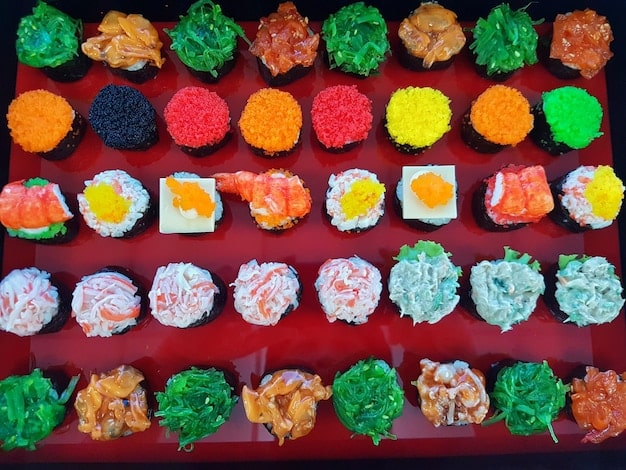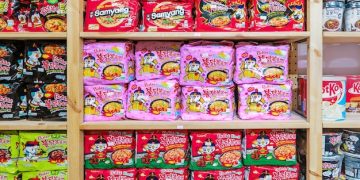Japanese Convenience Store Guide for US Travelers 2025

For US travelers in 2025, navigating Japanese convenience stores effectively means understanding their diverse offerings, payment methods, and cultural nuances to maximize convenience and enhance your travel experience, making every visit a discovery of unique local products and essential services.
Stepping into a Japanese convenience store, or “konbini,” as a US traveler in 2025 is far more than just a quick stop; it’s an immersive cultural experience, a culinary adventure, and an essential resource. This comprehensive guide, The Ultimate Guide to Japanese Convenience Store Shopping for US Travelers in 2025, is designed to demystify the konbini for you, ensuring every visit is effortless and enjoyable.
Understanding the Japanese Convenience Store Ecosystem in 2025
The ubiquity of convenience stores across Japan is remarkable, with major chains like 7-Eleven, FamilyMart, and Lawson dominating the landscape. These aren’t your average corner stores; they are hyper-efficient micro-hubs offering an astonishing array of products and services, making them indispensable for both locals and tourists. In 2025, their integration into Japanese daily life remains profound, offering a window into local customs and consumer habits.
The evolution of these stores has been driven by a relentless focus on customer convenience and innovation. From high-quality food options prepared daily to a myriad of utility services, they have mastered the art of maximizing utility in minimal space. For US travelers, understanding this ecosystem is the first step toward unlocking their full potential during your trip.
The Big Three Konbini Chains and What Sets Them Apart
While all konbinis offer core services, each of the “Big Three” has its unique allure. Knowing these subtle differences can enhance your shopping experience.
- 7-Eleven: Often praised for its extensive range of international ATM services compatible with US cards, and its popular “Seven Premium” brand of exclusive, high-quality products, from coffee to ready-to-eat meals.
- FamilyMart: Known for its “Famichiki” (fried chicken) and a broader selection of bento boxes and noodle dishes. They frequently collaborate with popular anime and video game franchises for limited-edition merchandise.
- Lawson: Distinguished by its Natural Lawson brand, focusing on organic and healthier options, and its popular “Karaage-kun” fried chicken nuggets. Lawson also has a strong presence in more rural areas.
Beyond these, look out for lesser-known chains like Ministop, which often features an in-store kitchen for hot foods, and SeicoMart, predominantly found in Hokkaido, famous for its unique regional products. Each chain’s distinct offerings contribute to the vibrant tapestry of Japanese daily life, inviting exploration and discovery for the curious traveler.
Navigating these stores effectively means appreciating their role as miniature community centers, where efficiency meets quality. They are cleaned meticulously, stocked precisely, and staffed by courteous individuals, reflecting the high standards prevalent throughout Japanese service industries. For the US traveler, this efficiency translates into immediate access to necessities and delightful discoveries, ensuring a seamless journey.
Essential Food & Drink Finds for the US Traveler
Japanese convenience stores are a culinary paradise, especially for those seeking quick, affordable, and surprisingly delicious meals. Forget soggy sandwiches; konbini food is an experience in itself, often rivaling casual restaurants in quality and variety. In 2025, the standards remain incredibly high, with fresh deliveries multiple times a day.
From breakfast onigiri to late-night ramen, the options seem limitless. You’ll find a remarkable emphasis on freshness and seasonal ingredients, reflecting Japan’s deep culinary appreciation. Exploring the food sections of a konbini is a vital part of the travel experience.
Must-Try Konbini Classics
Certain items have achieved legendary status among travelers and locals alike. These are the staples you absolutely cannot miss.
- Onigiri (Rice Balls): A staple, available with various fillings like salmon, tuna mayo, and plum. Easy to eat on the go and incredibly satisfying. Look for the triangle shape and tear open instructions for the seaweed wrap.
- Bento Boxes: Pre-packaged meals offering a balanced mix of rice, protein (fish or meat), and vegetables. They come in countless variations, from traditional to modern fusion.
- Sandwiches (Sando): Unlike Western counterparts, Japanese sandwiches feature incredibly soft white bread (shokupan) and unique fillings like egg salad (tamago sando) or fruit and cream.
- Fried Chicken & Hot Snacks: “Karaage” (fried chicken), “Famichiki,” and “Karaage-kun” are iconic hot snacks perfect for a quick bite. Don’t forget the steamed buns (nikuman) during colder months.
Beyond the classics, don’t shy away from exploring the chilled noodle sections, offering dishes like soba, udon, and pasta salads. These are perfect for light lunches or dinners. The bakery sections also boast a delightful array of sweet and savory pastries, from melon pan to curry bread. Each item is meticulously packaged, ensuring freshness and hygiene.

For beverages, the selection is equally diverse. Beyond standard soft drinks, you’ll find an astonishing variety of teas (green, oolong, barley), ready-to-drink coffees (hot and cold), and various fruit juices and energy drinks. In winter, keep an eye out for hot drinks in vending machines or heated displays near the register. This expansive range makes it easy to stay hydrated and energized throughout your travels, offering options for every taste and need.
Navigating Payment and Services for US Travelers in 2025
While Japan is making strides in cashless payments, cash remains king in many smaller establishments. However, convenience stores are at the forefront of digital payment adoption. For US travelers in 2025, understanding the preferred payment methods and available services can save time and hassle.
The efficiency of the checkout process is a hallmark of Japanese konbinis. Staff are trained to be swift and precise, often multi-tasking by preparing hot foods while simultaneously handling transactions. Familiarizing yourself with common payment options will ensure smooth interactions.
Cash, Credit Cards, and IC Cards
While cash is always accepted and often preferred for smaller transactions, an increasing number of konbinis accept major credit cards. Look for the Visa, Mastercard, or Amex logos at the register.
- IC Cards (Suica, Pasmo, Icoca): These rechargeable transportation cards are incredibly convenient for small purchases. You can easily top them up at ticket machines or directly at most konbini registers. They are scan-and-go simple, making them ideal for quick payments.
- Mobile Payments: Services like Apple Pay, Google Pay, and other contactless payment options are becoming more widespread. However, not all US-issued cards are compatible with Japanese terminals, so verify with your bank beforehand.
- ATMs: 7-Eleven stores are especially known for their international ATMs that accept US debit and credit cards for cash withdrawals. Lawson and FamilyMart also have ATMs, but their international card compatibility might vary, so 7-Eleven is often the safest bet.
Beyond payment, konbinis offer a surprising array of services. You can often pay utility bills, purchase tickets for events (via specialized kiosks or terminals like “Loppi” at Lawson or “FamiPort” at FamilyMart), and even send or receive packages. These services underscore their role as community lifelines.
Restrooms are not always available for public use. If you need one, it’s generally best to purchase something as a courtesy. The staff’s efficiency and polite demeanor contribute to the overall pleasant experience, even during peak hours. Learning a few basic Japanese phrases like “Arigato gozaimasu” (thank you very much) can also enhance your interactions, building bridges with local culture.
Unique or Seasonal Items to Discover
A true delight of Japanese convenience store shopping is the constant rotation of unique and seasonal products. Unlike the static inventory of many Western convenience stores, Japanese konbinis constantly introduce new limited-edition items, often tied to festivals, holidays, or specific times of the year. This dynamic inventory makes every visit a potential treasure hunt for the curious US traveler.
Seasonal offerings often reflect Japan’s deep connection to its four seasons, with flavors and ingredients changing to match the time of year. This commitment to seasonality means there’s always something fresh and exciting to discover, from spring cherry blossom-themed treats to autumn’s sweet potato delights.
Seasonal Delights and Limited Editions
- Spring (Sakura Season): Look for cherry blossom-flavored snacks, chocolates, and drinks. Pink hues dominate, and flavors are often subtly sweet and floral.
- Summer: Refreshing fruit-based desserts, chilled noodles, and lighter snacks are prevalent. Seasonal ice creams often feature unique Japanese fruit flavors.
- Autumn: Sweet potato (satsumaimo), chestnut (kuri), and pumpkin-flavored items appear. These are typically comforting and richer in flavor, reflecting the harvest season.
- Winter: Hot beverages, oden (a type of hot pot stew sold by the piece), and richer, chocolate-based treats are popular. Limited-edition seasonal Kit Kats are a perennial favorite across all seasons but especially prominent during festive periods.
Beyond seasonal flavors, keep an eye out for collaborations with popular anime series, video games, or even renowned chefs. These often result in unique packaging or exclusive merchandise that can make for fantastic souvenirs. The shelves might hold anything from limited-edition soda flavors to unusual savory snacks.
The sheer variety of beverages is also noteworthy. From an endless selection of green teas to bizarrely flavored sodas, exploring the drink cooler is an adventure in itself. Don’t overlook the impressive range of ready-to-drink coffees and innovative dairy products. The rotating stock ensures that even frequent konbini visitors will always find something new to pique their interest, making these stores an exciting part of the Japanese travel experience.

Common Etiquette and Tips for US Travelers
While Japanese convenience stores are welcoming, adhering to a few basic etiquette guidelines can enhance your experience and show respect for local customs. These practices reflect the broader Japanese emphasis on consideration and order, which permeate almost every aspect of daily life. Understanding these nuances will not only make your konbini visits smoother but also enrich your overall travel experience.
Japanese culture values politeness and efficiency, and these values are evident in the way konbinis operate. From queuing calmly to handling payments, a little awareness goes a long way in ensuring a harmonious interaction.
Konbini Dos and Don’ts
- Do queue politely: Always line up neatly, even if there’s only one customer ahead. Space is often limited, so be mindful of others.
- Do accept your change/receipt with two hands: It’s a sign of respect. The cashier will often use a small tray for this purpose.
- Don’t eat or drink directly after purchasing: While there are usually small eating areas outside or dedicated spaces within the store, it’s generally considered impolite to open and consume items while still browsing or at the checkout.
- Do separate trash: Japan has strict recycling rules. Konbinis usually have clearly marked bins for burnable, non-burnable, plastic bottles, and sometimes even cans. Separate your trash carefully.
- Don’t haggle: Prices are fixed.
When paying, cashiers will typically ask “Fukuro wa gozaimasu ka?” (Do you need a bag?) or make a gesture. A simple “Hai, onegaishimasu” (Yes, please) or “Iie, kekko desu” (No, thank you) will suffice. They will often ask if you need your items heated as well, particularly for bento boxes or hot snacks (“Atatamemasu ka?”). You can respond with “Hai” (yes) or “Iie” (no).
Understanding these small cultural practices not only streamlines your interactions but also demonstrates an appreciation for Japanese customs. It makes you a more considerate traveler and opens the door to more positive exchanges. The efficient and polite nature of konbini staff is a testament to the high standards of Japanese customer service, making every visit a pleasant one.
Digital Tools and Apps for Konbini Shopping in 2025
In 2025, technology continues to enhance the travel experience, and Japanese convenience stores are no exception. While navigating a konbini is generally straightforward, leveraging certain digital tools and apps can make your shopping even more efficient and enjoyable, especially for US travelers dealing with language barriers or unfamiliar products.
From translation apps to store locators, these digital aids can bridge the gap between foreign visitors and local services, turning potential frustrations into seamless interactions. Embrace these tools to unlock an even deeper level of convenience during your konbini adventures.
Recommended Apps and Digital Aids
- Google Translate / DeepL: These apps are invaluable for translating product labels, ingredient lists, and instructions. Use camera mode for instant translation of text in real-time, helping you identify allergens or specific food types.
- Google Maps: Essential for locating the nearest konbini. In Japan, these stores are so ubiquitous that you’re rarely far from one. Google Maps provides real-time walking directions and store operating hours.
- Chain-Specific Apps (e.g., 7-Eleven Japan, FamilyMart Japan): While often in Japanese, some offer features like store locators, special deals (though often requiring a Japanese phone number), and product information. They might also highlight new or limited-edition items.
- Currency Converters: Having a reliable currency converter app helps you quickly understand the cost of items in USD, making budgeting simpler and preventing overspending.
Many stores also offer free Wi-Fi, allowing you to use these apps on the go. Look for signs indicating “Free Wi-Fi” or similar. Connecting can be a quick process, sometimes requiring a simple registration or agreement to terms and conditions. This connectivity is particularly useful for researching products or services on the spot.
Using these digital tools not only simplifies your shopping experience but also empowers you to explore more confidently, allowing you to try new products and services without fear of misunderstanding. They bridge linguistic and cultural gaps, ensuring that even complex transactions or product choices become manageable. As a US traveler in 2025, integrating these tools into your konbini visits will undoubtedly elevate your overall trip convenience.
Beyond Food: Unexpected Konbini Offerings
While the culinary delights of Japanese convenience stores often steal the spotlight, their offerings extend far beyond snacks and meals. For US travelers in 2025, recognizing the full spectrum of services available at a konbini can be a game-changer, especially in unexpected situations. These stores are designed to cater to almost every immediate need, making them true lifesavers for tourists.
From essential toiletries to emergency supplies, the range of non-food items is impressively comprehensive. This broad utility transforms a simple convenience store into a multi-purpose hub, capable of solving various travel dilemmas with remarkable efficiency.
From Souvenirs to Emergency Essentials
- Travel Essentials: Forgot your toothbrush, shaving cream, or a small towel? Konbinis stock a surprising variety of travel-sized toiletries and basic hygiene products. They also often carry socks, underwear, and simple rain gear.
- Stationery: Japan is known for its high-quality stationery. Konbinis often have a small but well-curated selection of pens, notebooks, and other basic office supplies, perfect for journaling or quick notes.
- Over-the-Counter Medicine: For minor ailments like headaches or colds, you can find basic over-the-counter medicines, though the selection may be limited compared to a dedicated pharmacy.
- Merchandise & Souvenirs: Keep an eye out for limited-edition merchandise, especially during collaborations with popular cultural franchises or seasonal events. These can be surprisingly good and unique souvenirs.
- Bill Payment & Ticket Services: As mentioned, for those with a Japanese phone number or needing to pay for something specific, konbinis are crucial for paying various bills or purchasing tickets for concerts, theme parks, or transportation.
You can also find an array of seasonal items that aren’t food-related, such as fans in summer or heat warmers (kairo) in winter. The adaptability of konbinis to local needs and changing seasons reflects their commitment to ultimate convenience.
Even for basic necessities like batteries, chargers, or small electronics, konbinis often have you covered. Their ability to provide immediate solutions for a wide range of needs makes them an indispensable part of navigating Japan as a US traveler. Understanding these broader uses will empower you to view konbinis not just as places to grab a bite, but as comprehensive support systems during your journey.
| Key Point | Brief Description |
|---|---|
| 🍙 Food & Drink Excellence | Explore diverse, high-quality onigiri, bento, and seasonal snacks. Essential for quick, delicious meals. |
| 💳 Payment & Services | Utilize IC cards (Suica), credit cards, and 7-Eleven ATMs for cash. Access diverse utility services. |
| 🎌 Etiquette & Culture | Practice polite queuing, two-hand payment, and proper waste separation for a smooth experience. |
| 📱 Digital Assistance | Leverage translation apps and Google Maps for navigation, product understanding, and location services. |
Frequently Asked Questions About Japanese Konbini for US Travelers
While major credit cards (Visa, Mastercard, Amex) are generally accepted at most larger convenience stores like 7-Eleven, FamilyMart, and Lawson, it’s not guaranteed at every small branch. Using a portable IC card like Suica or Pasmo, or having some Japanese Yen cash on hand, is highly recommended for hassle-free transactions.
7-Eleven convenience stores are renowned for their international ATMs that reliably accept most US debit and credit cards for cash withdrawals. You can find 7-Bank ATMs in almost every 7-Eleven across Japan, making them the most convenient option for accessing Japanese Yen during your travels.
Yes, the vast majority of Japanese convenience stores, particularly the major chains like 7-Eleven, FamilyMart, and Lawson, operate 24 hours a day, 7 days a week. This round-the-clock availability makes them incredibly convenient for travelers at any time of day or night for food, drinks, and essential services.
Japanese convenience stores offer an impressive array of high-quality ready-to-eat meals, far beyond typical Western options. Expect to find fresh bento boxes with various Japanese dishes, onigiri (rice balls), sandwiches (sando), chilled noodles, and an assortment of hot snacks like fried chicken and steamed buns. Quality is consistently high.
While some larger convenience stores might have public restrooms, especially in less urban areas, it’s not a universal amenity. It’s generally considered good etiquette to make a purchase if you intend to use their facilities. Train stations, department stores, and public parks are often more reliable places to find restrooms.
Conclusion
Japanese convenience stores are truly extraordinary, offering far more than just basic necessities. For US travelers in 2025, they represent a convergence of convenience, culinary exploration, and cultural immersion. Mastering the konbini means embracing their unique offerings, from diverse food options and efficient payment systems to unexpected services and delightful seasonal finds. By understanding the etiquette and leveraging digital tools, you can transform every convenience store visit into a seamless and enjoyable part of your Japanese adventure, ensuring your trip is as convenient as it is memorable.





